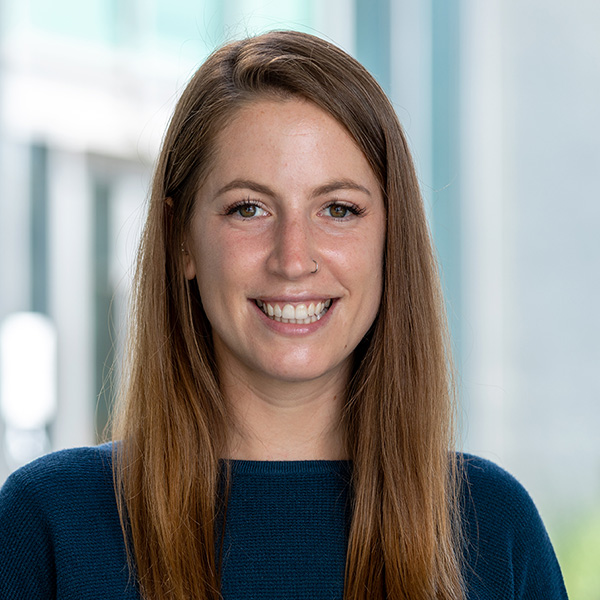Source: Interfolio F180

Danielle Grotjahn, PhD
Research Focus
The Grotjahn lab research program focuses on understanding how mitochondrial networks change shape in response to genetic, pharmacological, or environmental stress. By utilizing multidisciplinary imaging techniques, including cellular cryo-electron tomography (cryo-ET) and correlative light and electron microscopy (CLEM), our lab exposes the uncharted depths of cellular landscapes to define how the precise organization subcellular structures regulates mitochondrial homeostasis, and how disruptions to these molecular interactions gives rise to disease pathogenesis. Although commonly referred to as 'Powerhouses of the Cell' for their role in metabolism and ATP generation, mitochondria are also expert 'Stress Sensors of the Cell', reflecting their contribution as a central hub for integrating several cell stress pathways. Interestingly, mitochondrial networks undergo dramatic morphological remodeling in response to varying stress conditions, and in this manner, mitochondrial shape can be used as a readout for overall cellular health. In fact, a hallmark feature of many neurodegenerative diseases is the presence of mitochondria with severely altered morphologies that reflect their impaired function. Although the link between altered mitochondria and disease pathology is well established, the cellular mechanisms that facilitate mitochondrial shape changes that lead to organellar and cellular dysfunction remain poorly defined.
In the Grotjahn Lab, we are interested in studying the functional and structural interactions that mediate these stress-induced modulations to mitochondrial networks using techniques that directly bridge the intersection between cellular, molecular, and structural biology fields, including whole-cell cryo-electron tomography (cryo-ET), cryo-focused ion beam (cryo-FIB) milling, and correlative light and electron microscopy (CLEM). Through our high-resolution cellular imaging efforts, we shine new light the physiological and pathogenic mechanisms that contribute to mitochondrial dysfunction and disease.
Education
Ph.D. (Biophysics), The Scripps Research Institute, 2018B.S. (Biology), University of Wisconsin-Madison, 2010
Professional Experience
2021- Present
Assistant Professor, Department of Integrative Structural and Computational Biology (ISCB), Scripps Research
2019- 2021
Scripps Fellow, Department of Integrative Structural and Computational Biology (ISCB), Scripps Research
2018- 2019
Postdoctoral Researcher, Laboratory of Dr. Grant Jensen, Department of Biology, California Institute of Technology (Caltech)
2012-2013
Research Intern,Laboratory of Dr. Yevgenya Grinblat, Department of neuroscience, University of Wisconsin-Madison
2010- 2012
Associate Research Specialist, Laboratory of Dr. Francisco Pelegri, Department of Genetics and Medical Genetics,University of Wisconsin-Madison
Awards & Professional Activities
2023 Pew Scholar in the Biomedical Sciences Award, The Pew Charitable Trusts
2023 Damon Runyon-Rachleff Innovation Award: Phase 2, Damon Runyon Cancer Foundation
2022 Baxter Young Investigator Award, The Donald E. and Delia B. Baxter Foundation
2021 Damon Runyon-Rachleff Innovation Award: Phase 1, Damon Runyon Cancer Foundation
2018 Harold M. Weintraub Graduate Student Award, Fred Hutchinson Cancer Research Center
2016 ROCHE Scholarship Award, Achievement Rewards for College Scientists (ARCS)
2015 Graduate Research Fellowship, Achievement Rewards for College Scientists
2014 Graduate Research Fellowship, National Science Foundation (NSF GRFP)
2013 Graduate Research Fellowship, Dean’s award, Scripps Research Graduate program
2010 Graduated with Honors, University of Wisconsin-Madison
2010 Graduated with Distinction, University of Wisconsin-Madison
2009 The Cargill Benevenga Undergraduate Research Stipend
2006-2010 Dean's List, University of Wisconsin-Madison
2007-2010 Merit-based undergraduate scholarship, University of Wisconsin-Madison
Selected Publications
Barad, Benjamin A.; Medina, Michaela; Fuentes, Daniel; Wiseman, R. L.; Grotjahn, Danielle A. A surface morphometrics toolkit to quantify organellar membrane ultrastructure using cryo-electron tomography. Journal of Cell Biology 2023, 222, e202204093.
[View]
Perea, Valerie; Cole, Christian; Lebeau, Justine; Dolina, Vivian; Baron, Kelsey R; Madhavan, Aparajita; Kelly, Jeffery W.; Grotjahn, Danielle Ann; Wiseman, Rockland Luke
PERK Signaling Promotes Mitochondrial Elongation By Remodeling Membrane Phosphatidic Acid
. EMBO Journal 2023, 42, e113908.[View]
Mageswaran, Shrawan K.; Grotjahn, Danielle A.; Zeng, Xiangrui; Barad, Benjamin A.; Medina, Michaela; Hoang, My H.; Dobro, Megan J.; Chang, Yi-Wei; Xu, Min; Yang, Wei Y.; Jensen, Grant J. Nanoscale details of mitochondrial constriction revealed by cryo-electron tomography. Biophysical Journal 2023, S0006-3495, 481-482.
[View]
Perea, Valerie; Cole, Christian; Lebeau, Justine; Dolina, Vivian; Baron, Kelsey R.; Madhavan, Aparajita; Kelly, Jeffery W.; Grotjahn, Danielle A.; Wiseman, R. L. PERK Signaling Promotes Mitochondrial Elongation By Remodeling Membrane Phosphatidic Acid. EMBO Journal 2023, 42, e113908.
[View]
Grotjahn, D A.; Chowdhury, Saikat; Xu, Yiru; McKenney, Richard J.; Schroer, Trin A.; Lander, Gabriel C. Cryo-electron tomography reveals that dynactin recruits a team of dyneins for processive motility. 2018, 25, 203-207.
[View]
Grotjahn, D A.; Lander, Gabriel C. Setting the dynein motor in motion: New insights from electron tomography. 2019, 294, 13202-13217.
[View]
Lander, Gabriel C.; Lander, Gabriel C.; Grotjahn, Danielle A.; Chowdhury, Saikat; Basanta, Benjamin A guided approach for subtomogram averaging of challenging macromolecular assemblies.. Journal of structural biology: X 2020, 4, 100041.
[View]

